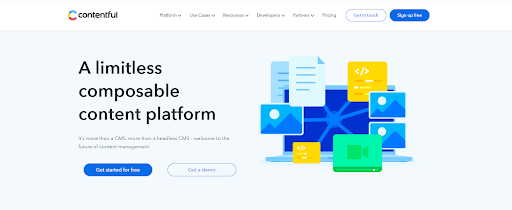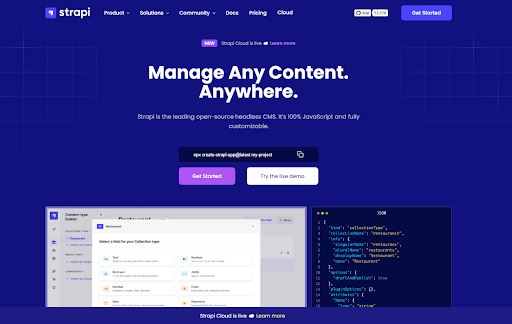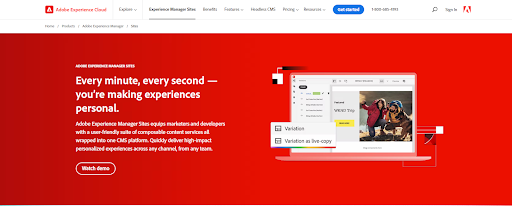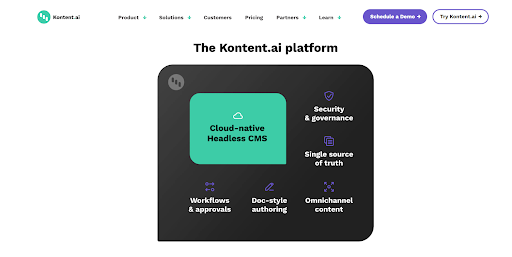/ Articles
Enterprise Headless CMS Unwrapped: Decoding the Game Changer for Large-Scale Content Management
Aakanksha Sharma
Content Marketer
- DATE PUBLISHED (17/4/2023)
- READ TIME (5MIN)
When it comes to headless CMS, there’s a lot more than meets the eye. A whole world of multi-layered architecture and cutting-edge APIs are behind exceptional customer experiences spanning a huge variety of screen types and sizes.
Enterprise headless CMS offers flexibility and intuitiveness that traditional CMS can't match. We are talking about -
Adapting to enterprise expectations
Seamless integration with diverse technologies
Better digital experiences at scale
To look closely at Enterprise Headless CMS, in this article, we’ll cover -
What is Enterprise Headless CMS
Headless CMS vs. Enterprise Headless CMS
Top 5 Enterprise Headless CMS Platforms
What is Enterprise Headless CMS?
An Enterprise Headless Content Management System (CMS) is a modern, flexible, and scalable approach to content management that caters specifically to the needs of large-scale organizations. It allows businesses to seamlessly manage and distribute content across various channels and platforms while maintaining a consistent brand experience.
Unlike traditional CMSs that tightly couple the content creation and presentation layers, a headless CMS focuses solely on the backend management of content, providing it via APIs to different front ends or devices. This decoupling allows developers to independently build and update the presentation layer, resulting in a more agile and efficient content management process.
Enterprise Headless CMSs offer advanced features that cater to the unique needs of large organizations, including:
Scalability: As enterprises grow and their content needs evolve, a headless CMS can efficiently scale to accommodate increasing demands.
Security: Enterprise Headless CMSs prioritize robust security measures to protect sensitive data and ensure compliance with industry regulations.
Flexibility: The decoupled nature of headless CMSs empowers developers to use any frontend technology, allowing businesses to adapt to emerging trends quickly.
Multi-channel publishing: With an API-driven architecture, content can be easily distributed across multiple platforms and channels, such as websites, mobile apps, and digital signage.
Personalization: Advanced personalization features enable enterprises to tailor content experiences for specific target audiences, improving user engagement and driving conversions.
Headless CMS Vs. Enterprise Headless CMS
Although headless CMSs and Enterprise Headless CMSs both decouple content management from the presentation layer, they differ in the features and capabilities they provide. But first, let’s examine how an enterprise's content requirements vary from a small business's.
Enterprises often have multiple brands or product lines, each with unique content needs. As a result, they need to manage content in multiple languages for a global audience and maintain consistency across various marketing channels. Additionally, large organizations may have numerous internal departments, each producing and managing its content.
Some examples of complex content requirements for an enterprise include:
1. Multilingual content
Enterprises need to manage and deliver content in various languages to cater to their global audience. This requires a CMS that can handle multiple language versions of the same content and support localized content variations.
2. Omnichannel content delivery
Large organizations often use multiple marketing channels, such as websites, mobile apps, email marketing, and social media. They need a CMS capable of seamlessly delivering consistent content across all these channels.
3. Advanced content personalization & segmentation
While content personalization is essential for businesses of all sizes, enterprises often require more advanced personalization capabilities to cater to their diverse and extensive user base. They need a CMS that can manage and deliver highly targeted content based on a wide range of user attributes, such as behavior, preferences, demographics, location, and device type.
Additionally, enterprises may need to integrate their CMS with advanced analytics and data management platforms to derive deeper insights and enable more precise content targeting and segmentation.
4. Collaboration across teams
With multiple departments and teams involved in content creation and management, enterprises need a CMS that supports advanced collaboration features, such as content approval workflows, versioning, and granular permissions.
5. Dynamic content
Large organizations often require their content to be dynamic and adaptable, allowing for real-time updates, interactive elements, and integration with third-party services like e-commerce platforms or CRM systems.
Some key distinctions between Headless and Enterprise Headless CMS:
1. Designed for larger organizations
A regular headless CMS caters to small and medium-sized businesses. An Enterprise Headless CMS is intended for large-scale organizations with more complex content requirements, ensuring optimal performance even as the organization expands.
2. Enhanced security features
Both systems prioritize security, but Enterprise Headless CMSs offer more advanced security measures, including single sign-on, role-based access control, audit trails, and compliance with stringent industry regulations.
3. Advanced collaboration and workflows:
Enterprise Headless CMSs provide better collaboration and workflow tools, such as content approval workflows, versioning, content scheduling, and granular permissions, enabling large teams to work together efficiently and maintain content consistency.
4. Broader integration capabilities:
Both types of CMSs offer integration options. However, Enterprise Headless CMSs typically have more extensive pre-built integrations and robust APIs, allowing seamless connection with existing technology stacks and easier integration with third-party services.
5. Dedicated support and SLAs:
Enterprise Headless CMSs often include dedicated support and service level agreements (SLAs) to ensure maximum uptime and reliable performance, providing 24/7 customer support, access to dedicated account managers, and faster response times in case of issues or emergencies.
Top Enterprise Headless CMS Platforms
1. Contentful

Contentful is a highly popular, cloud-based headless CMS that focuses on delivering content via APIs to any platform or device. It is designed to handle complex content structures, making it suitable for enterprises with extensive content requirements.
Features of the platform:
A library of shared content models
Built-in Content Workflows
Structured Content for Reusability
Reduced Time-to-Market
Role-based Access
Advanced SEO features
Pros of the platform:
Easy-to-use interface
Strong API capabilities
Extensive integration options
SDKs for popular programming languages
Cons of the platform:
Limited built-in content personalization features
Pricing can be expensive for large-scale projects
2. Strapi

Strapi is a self-hosted, open-source headless CMS that enables developers to create, manage, and distribute content efficiently. It offers a customizable API and supports GraphQL for more advanced use cases.
Features of the platform:
Customizable APIs
Role-based access control
Dedicated Customer Success Manager
Multilingual websites/apps building support
Custom Content Type Builder
Advanced File Management
Pros of the platform:
Open-source and free to use
Customizable and extensible
Supports GraphQL out of the box
Active community and support
Cons of the platform:
Lacks some enterprise-specific features
It may require more development effort for customization
3. Adobe Experience Manager (AEM)

Adobe Experience Manager is a comprehensive content management solution designed for large organizations. With API-first architecture, it offers many advanced features, including robust scalability, security, and extensive integration capabilities.
Features of the platform:
Sensei GenAI supported Universal Editor
Customizable content layouts for Omnichannel experiences
Automated Workflows
ML support for Cross channel content
Pros of the platform:
Powerful content management capabilities
Integration with other Adobe products
Advanced personalization features
Strong support for multi-language content
Cons of the platform:
Steep learning curve
High licensing costs
4. Kentico Kontent

Kentico Kontent is a cloud-based headless CMS that provides enterprises with an easy-to-use platform to manage and deliver content across various channels. It offers features like content collaboration, workflow management, and integration capabilities.
Features of the platform:
Multichannel Content Support
Collaborative Content Editor
Web Spotlight for Web & App Previews
Language Localization & Omnichannel Delivery
Custom workflows
Pros of the platform:
Intuitive user interface
Robust content collaboration tools
Strong API capabilities
Good documentation and support
Cons of the platform:
Limited built-in personalization features
Customization options may be limited.
5. Magnolia CMS
Magnolia CMS is an enterprise-grade, Java-based headless CMS that offers powerful content management and delivery capabilities. It provides advanced personalization, multi-site management, permission-based access, and strong security.
Features of the platform:
Flexible APIs
Unlimited Integrations
Interoperable User Experience
Modern block-based editing
Visual editing of single-page applications
Pros of the platform:
Highly extensible and customizable
Integration with popular frontend frameworks
Strong security features
Support for multi-site management
Cons of the platform:
The steeper learning curve for non-technical users
It may require more development effort for customization
Conclusion
As we've explored, Enterprise Headless CMSs differ from regular headless CMSs in various aspects, such as scalability, security, collaboration and workflow capabilities, integration options, and support.
When choosing an Enterprise Headless CMS, organizations must consider ease of use, integration capabilities, personalization features, and support to ensure the chosen platform aligns with their content management goals and business objectives.
By selecting the suitable Enterprise Headless CMS, enterprises can unlock the full potential of their content, delivering personalized and consistent experiences across channels and devices and ultimately driving user engagement and business growth.
P.S.: I’ve talked in depth about what headless commerce is, the benefits it offers, and how its architecture works in previous articles. You can check out the links we provided if you need a refresher.